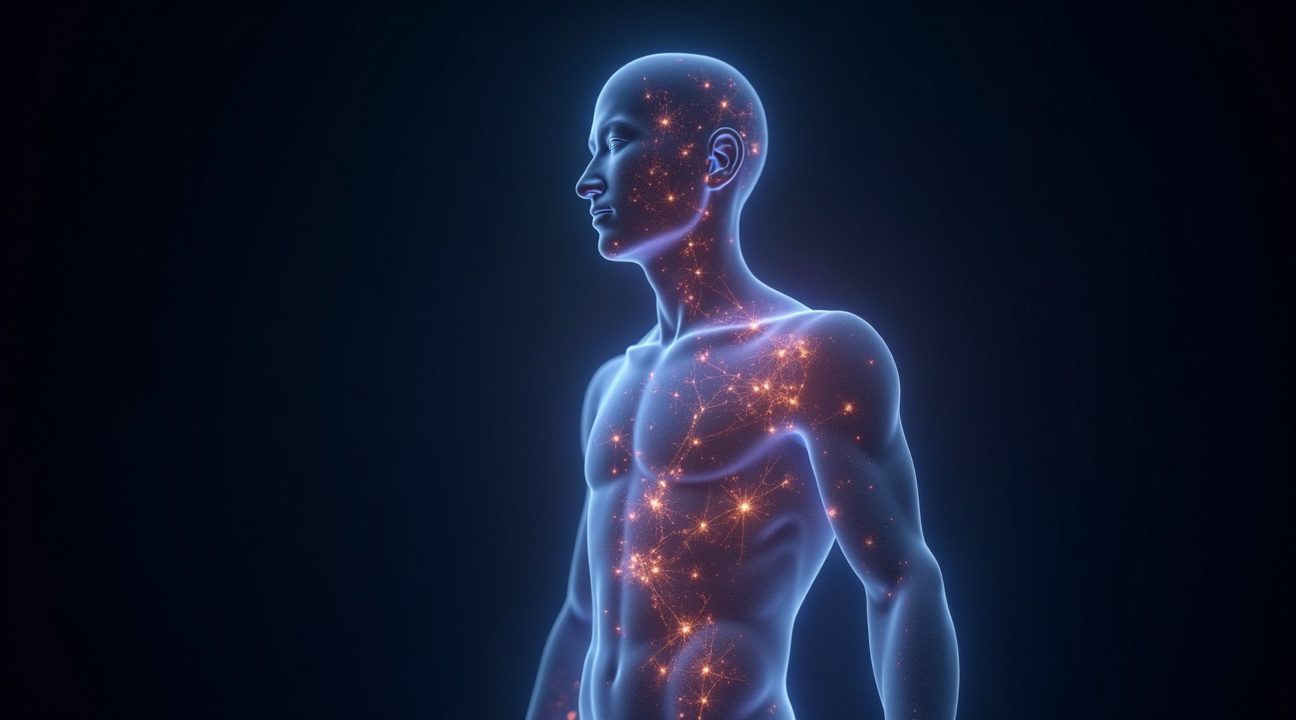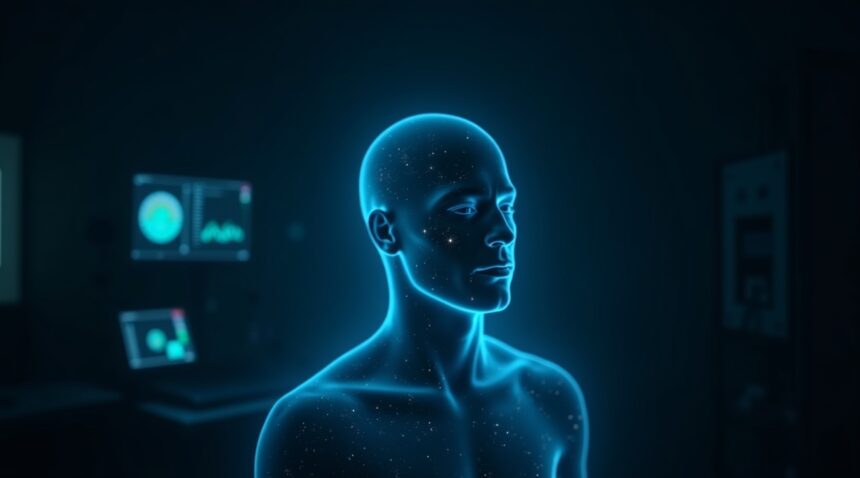Scientific research confirms that humans emit invisible light called ultraweak photon emission (UPE), which represents a measurable byproduct of cellular metabolism that advanced imaging technology can now capture.
This bioluminescent glow is approximately 1000 times weaker than what human eyes can detect. The emission, crucially, vanishes immediately when biological processes cease at death. This provides scientists with concrete evidence of a quantum-level signature that clearly distinguishes living tissue from non-living matter.
Key Takeaways
- Human bodies continuously emit invisible light through ultraweak photon emission, arising from cellular energy production and reactive oxygen species generated in normal metabolism.
- Advanced CCD cameras and imaging tools can detect this light in laboratory environments, showing consistent emission patterns that follow circadian rhythms, with peak intensity occurring in the late afternoon.
- This invisible glow vanishes upon death, marking the cessation of cellular metabolic activity and offering a measurable biological distinction between life and death.
- Facial regions like the forehead, cheeks, and neck emit stronger UPE due to higher concentrations of metabolically active cells present in these areas.
- This scientific finding parallels ancient beliefs in human auras, potentially transforming future approaches in medical diagnostics, real-time health monitoring, and the study of life’s quantum-level mechanics.
You can read more about the phenomenon in this scientific article on UPE from the National Institutes of Health, where researchers explore how light emission reflects biological processes that are otherwise invisible to the human eye.
Your Body Produces an Invisible Glow That Scientists Can Now Capture on Camera
I’ve discovered that humans actually emit light—not metaphorically, but quite literally. This phenomenon, known as ultraweak photon emission (UPE), represents one of the most fascinating aspects of biological physics that scientists can now document with precision.
The invisible light radiating from human skin exists at levels roughly 1000 times weaker than what our eyes can detect. Scientists refer to these emissions as biophotons or biological bioluminescence, and they’re constantly streaming from every person’s body. Unlike the dramatic glow depicted in science fiction, this natural luminescence remains completely imperceptible to human vision.
Advanced Camera Technology Reveals Human Light Emission
Scientists capture this elusive phenomenon using highly sensitive CCD cameras specifically designed for low-light detection. The imaging process requires extraordinary conditions that eliminate any external light sources. Researchers conduct these experiments in light-tight, temperature-controlled rooms where absolute darkness becomes essential for accurate measurements.
The technical demands of photographing human bioluminescence push imaging technology to its limits. Scientists must take measurements every three hours over several consecutive days to document the consistent patterns of light emission. A groundbreaking 2009 study successfully demonstrated this technology’s capability to visualize human photon emission through multi-hour imaging sessions.
These extended observation periods reveal that biophoton emission isn’t random but follows predictable patterns throughout different times of day. The intensity fluctuates based on various biological factors, creating a unique luminous signature for each individual. Scientists have found that metabolic processes within cells generate these photons as natural byproducts of cellular activity.
The light originates from biochemical reactions occurring constantly within living tissue. When cells process energy, they occasionally release photons as excess energy dissipates. This process happens continuously throughout life, making every person a living light source that science can now measure and analyze.
Advanced imaging techniques have opened new research possibilities for understanding human biology. Scientists can potentially use biophoton patterns to study:
- Health conditions
- Cellular function
- Consciousness itself
The invisible glow that surrounds each person represents a measurable aspect of life that vanishes completely at death, providing scientific validation for ancient concepts about human luminescence.
This discovery bridges the gap between mystical traditions that spoke of human auras and modern scientific measurement. What previous generations described in spiritual terms, contemporary researchers can now document through precise technological methods that capture the literal light of human existence.
This Mysterious Light Vanishes Immediately When Life Ends
I’ve discovered something remarkable through studying the latest research on ultraweak photon emission — this invisible light disappears instantly when death occurs. Scientific studies reveal that the bioluminescent glow surrounding all living beings vanishes the moment biological processes cease, creating a clear marker between life and death that’s measurable at the quantum level.
Researchers have documented that ultraweak photon emission rapidly diminishes after biological death, establishing a direct connection between this mysterious light and the cessation of metabolic activity. The correlation isn’t gradual or delayed — it’s immediate and definitive. Laboratory experiments with animals demonstrate a marked and rapid drop in UPE immediately following death, providing concrete evidence that this phenomenon serves as a biological switch.
Evidence From Laboratory Studies
Before-and-after imaging studies with mice have produced compelling results that showcase this dramatic change. Scientists captured these key findings through careful observation:
- Continuous emission during life shows steady biophoton output throughout normal biological functions
- Immediate decline in bioluminescence occurs within moments of death
- Complete cessation of detectable photon emission follows shortly after metabolic shutdown
- No residual light activity persists in deceased tissue samples
The experiments reveal that photon emission after death drops to undetectable levels, confirming that this light represents a byproduct of living metabolism. Once cellular metabolism stops completely, the corresponding light production halts as well. This creates an unmistakable biological signature that distinguishes living tissue from deceased matter.
I find it fascinating that this discovery connects to broader questions about consciousness and existence that scientists continue exploring. While some researchers investigate whether aliens have been here observing our bioenergetic signatures, others focus on how our brains process mysterious phenomena like déjà vu experiences.
Evidence strongly suggests that humans experience the same biophoton extinction pattern, though direct imaging immediately after human death isn’t typically performed for ethical reasons. Researchers extrapolate findings from animal studies to human subjects based on similar metabolic processes and cellular structures. The fundamental biology remains consistent across mammalian species, making these conclusions scientifically sound.
Postmortem bioluminescence studies show that metabolism serves as the driving force behind this invisible illumination. Cellular respiration generates the energy that produces these quantum light emissions, and when respiration ceases, photon production stops immediately. This relationship demonstrates how deeply connected our physical existence is to quantum-level phenomena.
The implications extend beyond simple biological observation. This research suggests that every living being carries a measurable energy signature that distinguishes them from non-living matter. Similar to how some people can smell impending rain through subtle environmental changes, sensitive equipment can detect these quantum emissions that mark the presence of life itself.
Understanding biophoton extinction patterns could revolutionize medical monitoring and biological research. The immediate cessation of UPE after death provides scientists with a new tool for studying the exact moment when biological systems shut down. This knowledge bridges the gap between traditional biology and quantum physics applications in living systems.
Current research continues expanding our understanding of how these quantum emissions relate to various biological states. Scientists are investigating whether different health conditions affect biophoton intensity and whether this invisible light carries information about cellular activity. The field opens new possibilities for non-invasive medical diagnostics and biological monitoring techniques.
The mystery deepens when considering that this light exists in dimensions beyond our normal perception, operating in quantum spaces that extend beyond our typical three-dimensional understanding. Just as researchers explore concepts like the ninth dimension and search for life building blocks on other worlds, the study of human bioluminescence reveals hidden aspects of existence that science is only beginning to comprehend.
Your Face Glows Brightest and Follows Your Body Clock
I find it fascinating that human bioluminescence isn’t random—it follows a predictable pattern that mirrors our internal clock. The emission peaks naturally in late afternoon, then gradually diminishes as night approaches. This rhythmic glow corresponds directly to our body’s metabolic cycles and energy production patterns.
Facial Features Lead the Light Show
The strongest emissions concentrate on specific areas of the face, with the forehead, cheeks, and neck producing the most intense light. Interestingly, these bright spots don’t align with heat patterns visible through thermal imaging. This distinction proves that bioluminescence operates independently from body temperature, suggesting a different biological mechanism drives this phenomenon.
The intensity varies based on metabolic activity levels and follows circadian rhythms controlled by cellular energy processes. Physics research reveals that mitochondria—the powerhouses of our cells—play a central role in producing this light through reactive oxygen species (ROS) generation.
Most emitted light falls within the visible and near-visible spectrum, though the intensity remains too weak for human eyes to detect without specialized equipment. The glow represents a byproduct of normal cellular respiration and energy metabolism that occurs continuously throughout our lives.
Circadian rhythm influences this biological light show significantly. As our internal clock regulates hormone production, sleep cycles, and metabolic processes, it simultaneously controls the ebb and flow of our natural luminescence. Late afternoon represents peak emission time because cellular activity reaches maximum efficiency during these hours.
Mitochondria generate ATP (cellular energy) through complex chemical reactions that inevitably produce ROS as waste products. These reactive molecules interact with other cellular components, occasionally releasing photons in the process. Scientific studies demonstrate how this process varies predictably throughout 24-hour cycles.
The connection between metabolic activity and light emission explains why facial regions glow most intensely. These areas contain high concentrations of active cells involved in sensory processing, communication, and environmental interaction. Blood vessels near the surface also contribute to increased cellular activity in facial tissues.
Understanding this natural rhythm opens new possibilities for health monitoring and circadian rhythm research. The intensity patterns could potentially indicate metabolic health, sleep quality, or even early signs of cellular dysfunction before symptoms become apparent through traditional methods.
The Science Behind Your Inner Light Comes From Cellular Energy Production
The faint glow emanating from the human body stems from the fundamental processes that keep us alive. This phenomenon connects directly to normal metabolic processes, particularly those occurring within the mitochondria – the powerhouses of our cells. Every breath taken and every nutrient consumed contributes to this remarkable biological light show happening at the cellular level.
How Cellular Energy Creates Light
The process begins with reactive oxygen species (ROS), which form as natural byproducts of mitochondrial energy generation. These highly reactive molecules interact with proteins, lipids, and other cellular components during routine metabolic activities. As these interactions occur, the affected molecules become excited and reach higher energy states. The magic happens when these excited molecules return to their lower energy states – they emit weak photons, creating what scientists call ultraweak photon emission (UPE).
This biological light production differs significantly from the spectacular displays seen in fireflies or marine organisms. While those creatures use specialized chemicals through the luciferin-luciferase system to create visible bioluminescence for communication or defense, human UPE represents an incidental consequence of life chemistry rather than an evolutionary adaptation. The human body’s glow isn’t designed for signaling or visibility – it’s simply a byproduct of the physics governing cellular energy production.
The intensity of this emission correlates directly with metabolic activity. Areas of the body with higher cellular energy demands typically produce more photons. This connection between metabolism and light emission explains why the phenomenon diminishes and eventually ceases when biological processes stop functioning. Mitochondrial function drives the entire process, making cellular energy the true source of this invisible radiance.
Understanding the role of oxidation processes helps clarify why this light exists. Chemical reactions within cells constantly generate and consume energy, creating the conditions necessary for photon emission. Unlike the controlled bioluminescence found in other organisms, human UPE reflects the continuous biochemical activity that sustains life itself. The reactive oxygen species act as intermediaries, facilitating the energy transfers that ultimately result in light emission.
This cellular light production represents one of many fascinating aspects of human biology that remain largely invisible to casual observation. The photons emitted are far too weak for the naked eye to detect, requiring sophisticated equipment to measure and study. Yet this phenomenon demonstrates how even the most basic life processes can produce effects that extend beyond their primary biological functions.

How Scientists Study and Use This Invisible Human Light
I find the technology behind detecting human biophoton emissions absolutely fascinating. Scientists employ sensitive CCD cameras and specialized imaging equipment to capture and map the body’s invisible light in real time. These sophisticated detection systems can visualize photon emissions that would otherwise remain completely hidden from our naked eyes.
Advanced Detection Methods and Laboratory Requirements
The process of studying this invisible light demands precise laboratory conditions. Technology requires light-tight, temperature-controlled rooms where researchers conduct multi-hour imaging sessions following strict laboratory protocols. I’ve learned that even the smallest amount of external light can interfere with these delicate measurements, making controlled environments absolutely essential.
CCD technology forms the backbone of these detection systems, capturing photons at incredibly low levels. Scientists can monitor these emissions continuously, creating detailed maps of how biophotons distribute across different parts of the human body. The imaging process reveals patterns that change based on various physiological states and conditions.
Applications in Medical Research and Diagnostics
Bioluminescence and photon emission have revolutionized medical and biological research across multiple fields. Scientists regularly use these techniques for several critical applications:
- Imaging gene expression patterns within living tissues
- Tracking protein interactions at the cellular level
- Monitoring tumor development and progression
- Studying cell physiology in real-time conditions
- Observing metabolic processes as they occur
Bioluminescence imaging proves significantly more sensitive than standard fluorescence imaging techniques. This enhanced sensitivity allows researchers to monitor living cells at single-cell resolution, providing unprecedented detail about cellular behavior. I consider this capability particularly valuable for understanding how individual cells respond to different treatments or environmental changes.
The contrast between natural human emissions and enhanced laboratory techniques becomes apparent in animal research. Scientists enhance bioluminescence using genetic engineering for clearer visualization in animal models, incorporating compounds like luciferin and luciferase to amplify light production. However, naturally occurring human UPE doesn’t undergo this artificial enhancement, making detection more challenging yet scientifically pure.
Medical diagnostics benefits enormously from these imaging techniques. Doctors can potentially track disease progression, monitor treatment effectiveness, and identify abnormal cellular activity without invasive procedures. Real-time monitoring capabilities allow healthcare professionals to observe changes as they happen, rather than relying solely on static snapshots.
The applications extend beyond traditional medicine into cutting-edge research areas. Scientists study how physics influences biological systems at the quantum level, exploring connections between consciousness and cellular activity. Some researchers even investigate whether certain individuals possess enhanced sensory capabilities, similar to those who can smell impending rain.
These detection methods have opened new possibilities for understanding human biology at its most fundamental level. I believe the technology will continue advancing, making it easier to study the subtle energy patterns that characterize living systems. The ability to visualize previously invisible aspects of human physiology represents a significant step forward in our scientific understanding of life itself.
Current research protocols demonstrate that biophoton detection requires patience and precision. Scientists must account for numerous variables, from room temperature fluctuations to the subject’s emotional state, as these factors can influence emission patterns. The resulting data provides insights into the dynamic nature of human biology that traditional medical imaging simply cannot capture.
This invisible light continues revealing secrets about human physiology that scientists never suspected existed. Each advancement in detection technology brings new opportunities to understand the subtle electromagnetic signatures that distinguish living tissue from non-living matter, potentially revolutionizing how we approach both medicine and our understanding of life itself.
How Human Bioluminescence Compares to Nature’s Glowing Creatures
The human body’s faint glow represents a fascinating yet fundamentally different phenomenon compared to the spectacular light shows found throughout nature. While fireflies create brilliant flashes visible from yards away, human bioluminescence produces light so weak that it remains completely invisible to the naked eye.
Intensity and Visibility Differences
The contrast in brightness between human and natural bioluminescence is staggering. Fireflies generate light powerful enough for humans to see clearly on summer evenings, while human emissions require ultrasensitive photomultiplier tubes and specialized cameras for detection. This massive difference in intensity reflects entirely different biological processes at work.
Human bioluminescence emerges as an unintentional byproduct of cellular metabolism and reactive oxygen species formation. Every time cells break down nutrients for energy, they create free radicals that interact with proteins and other molecules, occasionally releasing photons. This process occurs constantly but produces incredibly weak light output.
Fireflies, by contrast, operate sophisticated biochemical machinery specifically evolved to create visible illumination. Their light-producing system relies on an enzyme called luciferase acting upon a substrate called luciferin, creating a highly efficient chemical reaction that converts energy directly into photons. This enzymatic process allows fireflies to control their light output precisely, turning their glow on and off at will.
Purpose of Bioluminescence
The fundamental purposes behind these different forms of bioluminescence reveal another striking contrast. Human light emission serves no known biological function – it’s simply a side effect of normal metabolic processes. Scientists haven’t identified any adaptive advantage or evolutionary purpose for this weak glow that surrounds living human bodies.
Natural bioluminescent creatures, however, have evolved their glowing abilities for critical survival functions:
- Mating Displays: Fireflies use their flashing patterns for communication and to attract mates, with species-specific signals.
- Defense: Deep-sea creatures create sudden bursts of light to disorient or deter predators.
- Hunting: Some organisms use light to attract or locate prey in dark environments.
Detection Methods
Detection methods highlight another key difference between human and natural bioluminescence. Observing fireflies requires nothing more than human eyesight during twilight hours, while detecting human light emission demands sophisticated laboratory equipment. Physics advances have made it possible to capture these ultra-weak emissions, but the technology required remains far beyond everyday accessibility.
Persistence After Death
The persistence of bioluminescence after death varies dramatically between humans and other glowing organisms. Human light emission disappears rapidly once metabolism ceases, typically within minutes as cellular processes shut down and reactive oxygen species production stops. The body’s glow fades as quickly as the biochemical reactions that created it.
Some naturally bioluminescent organisms can maintain their glow briefly after death, depending on their specific chemistry. For example:
- Certain marine plankton continue producing light post-mortem using luciferin-luciferase reactions that function temporarily without active cellular metabolism.
However, even these reactions are short-lived as the biological components deteriorate.
Wavelength Differences
The wavelengths of light produced also differ significantly. Human bioluminescence typically peaks in specific regions of the visible spectrum. By contrast, natural organisms have evolved to utilize wavelengths that best support their environments and behaviors. Examples include:
- Deep-sea creatures: Usually emit blue light as it travels furthest in water environments.
- Terrestrial organisms: May produce green, yellow, or red light optimized for visibility on land.
Subtle Yet Intriguing
Understanding these distinctions helps explain why human bioluminescence remained undiscovered until the advent of modern scientific instruments. Unlike the dramatic displays of fireflies or glowing fungi, human light emission exists at the very threshold of detectability.
This weak glow serves as a reminder that extraordinary senses and abilities exist throughout nature, even when they operate beyond our normal perception.

Sources:
Tohoku Institute of Technology – “Imaging of Ultraweak Photon Emission from Human Body Displaying Diurnal Rhythm”
Scientific American – “Humans Glow in Visible Light”
Live Science – “Humans Glow in Visible Light”
Nature – “Ultrasensitive bioluminescence imaging of single cells and tissues”


